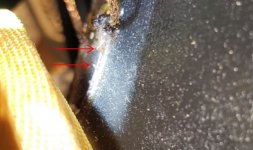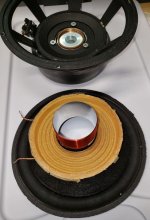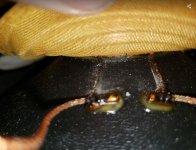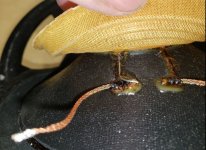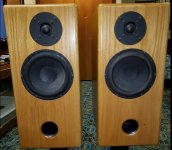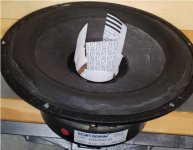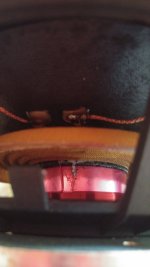Built a system about 20 years ago using ScanSpeak 18W/8545 woofers. When I went down to listen to music this morning I found that one of the woofers had died. I pulled it out and discovered that one of the voice coil leads running up the side of the cone had broken. I probed around a bit with an xacto knife, hoping to uncover the broken area and maybe solder them back together, but sadly the leads are aluminum and very brittle. See attached picture - red arrows point to the two ends that need to be connected (might be hard to see). I don't see this as repairable since they are aluminum, so I think it is the end of the road for this woofer, but thought I'd see if anyone has a bright idea. Madisound sells a replacement so I'll probably go that route.
Attachments
If you can get your hands on some aluminum shavings/as fine as possible and mix it in with superglued a two part glue, and mix in the aluminum dust/shaving into a very think paste and try that. You could do a test spot and then check it with a meter to see if it could hold a current. I e do t this before and it’s worked before. As long as it’s not on a spit that’s going to be moving back and forth
What do you have to lose ?
What do you have to lose ?
Before applying this to the Woofer I would definitely do a test run.
I would search the web for tricks and methods for soldering aluminium. I do actually know one that can be used to solder wires to larger aluminium surfaces but that wouldn't be practical here.
Regards
Charles
I would search the web for tricks and methods for soldering aluminium. I do actually know one that can be used to solder wires to larger aluminium surfaces but that wouldn't be practical here.
Regards
Charles
cant make out much from your pic, but this could be a similar problem as for the 13m drivers
Scan-Speak 13M/8636 - sudden death
Scan-Speak 13M/8636 - sudden death
Perhaps crimping them with a connector pin (Serial / VGA D-Sub comes to me in mind)...
Are You sure the voice coil is aluminum ? How is it connected to the flexible wires ?
I can see some solder blobs on the top of the picture.
I've seen mostly on cheap headphones unsolderable copper wires....No it's not the ennamel.
Are You sure the voice coil is aluminum ? How is it connected to the flexible wires ?
I can see some solder blobs on the top of the picture.
I've seen mostly on cheap headphones unsolderable copper wires....No it's not the ennamel.
Yes, that is exactly the same issue! Thanks for the reference.cant make out much from your pic, but this could be a similar problem as for the 13m drivers
Scan-Speak 13M/8636 - sudden death
I'm pretty sure it is aluminum because as I scraped off the glue/covering the color looks like aluminum, not copper. It is hard to get a good picture as there is not much room there. The spec for the speaker says "42mm Voice Coil w. Alu foil". At the top of the picture is a black blob, probably covering a crimp connection between the aluminum lead and the braided wire. The wire was very brittle and kept breaking off, not at all like I would expect copper to behave, although I think the break was caused by corrosion, similar to what is described in the link provided by ctrix.Perhaps crimping them with a connector pin (Serial / VGA D-Sub comes to me in mind)...
Are You sure the voice coil is aluminum ? How is it connected to the flexible wires ?
I can see some solder blobs on the top of the picture.
I've seen mostly on cheap headphones unsolderable copper wires....No it's not the ennamel.
I'm not sure, nor is it clearly visible where the connection has failed exactly. Is it between the voice coil and the tinsel wire, or is the tinsel wire loose from the cone? In the 1st case there's an issue indeed, as VC's that are wound from aluminium wire aren't that unusual, even in professional drivers.
Best regards!
Best regards!
The break is in the wire running up the side of the cone from the voice coil to the braided wire. The break was very close to the attachment point to the braided wire and looked corroded. Initially I could easily probe the two sides of the break with an ohmmeter and determine where the break was. I attempted to uncover a sufficient amount of the wire running along the cone to solder to it, however, it is extremely brittle and as soon as I uncover enough to attempt soldering, it breaks off. I've now chased the wire all the way back to the spider so would need to disassemble the speaker to attempt repair, and that is beyond my capability (and/or ambition). The driver in the matching speaker is no longer pristine either as I had to repair a puncture in the rubber surround a few years ago, so at this point, and after 20 years of listening pleasure, I'm just going to replace both drivers. But hey - the tweeters are sill in great shape! Thanks for all the good ideas.
Bought replacements at Madisound - have them burning in for a couple days before I measure specs to see how well they'll replace the originals. New ones (01 suffix) are supposed to be improved. Of course I couldn't let the dead one just sit there, so with the help of the link provided by ctrix (Scan-Speak 13M/8636 - sudden death), I removed the cone/spider assy from the frame without too much trouble using an xacto knife and alcohol (which I think might have slightly softened the adhesive). The corrosion on the speaker lead caused me to mistakenly think it was aluminum - clearly it is copper and my next task is to figure out how to sneak in a small wire connection to replace the old. Also have some glue recommended by SimpySpeakers on the way. Couple pictures pasted below. First one shows my handiwork; second one shows a close up of the lead running up the side of the speaker: the lead on the left was the one I tried to repair and is no longer there, the one on the right is still there but seems to also be showing signs of corrosion so should also be replaced.
Attachments
Tack soldered a lead onto the short stub of the voice coil still showing beyond the spider and coated it with some left over SimplySpeakers MI-3035 adhesive. In retrospect, maybe I should have used epoxy to give the solder joint some mechanical support. After cleaning the right lead it didn't really show corrosion so I just coated it with adhesive. The matching woofer looked fine - no corrosion - pristine leads. Now just waiting on a new tube of SimplySpeakers MI-3035 adhesive to reattach surround and spider. Pic of repair below. Also decided to postpone any testing or burn-in of the new speakers, because if this is successful I'll probably just return them.
Attachments
Last edited:
OK, just to bring this story to an end, I have glued surround & spider back on and remounted the speakers. They measure well (impedance and acoustically) and sound fantastic once again, so I'm pretty pleased that I was able to repair them thanks to help from this forum. FYI, the speakers were constructed circa 1999 from a Mike McCall design - picture of the pair below - repaired woofer on the left.
Attachments
Did repair a few woofers and subs with similar issues - the wire from voice coil just died at the attachment point with lead wire. Most of the time or rather all the time the culprit was too much power or clipping amp. Strange that voice coil was perfectly in tact. Also my Focal (no ferrofluid) tweeter failed in similar fashion, the leads from vc are as tiny as the voice coil wire.
The SB tweeters seem to be very well designed - by chance I forgot to limit low freq the range while testing. I couldn't hear the tweeter and I moved my head the dome was moving some 2.5-3 mm p-p - my eyes almost popped out. The 29RDC did survive, one hell of a tweeter.
The SB tweeters seem to be very well designed - by chance I forgot to limit low freq the range while testing. I couldn't hear the tweeter and I moved my head the dome was moving some 2.5-3 mm p-p - my eyes almost popped out. The 29RDC did survive, one hell of a tweeter.
My failure appeared to be corrosion related, not temperature. I'm guessing perhaps a too-active flux not being cleaned up properly after soldering, but who knows. Both leads on the side of the cone showed evidence of corrosion, but only one had broken. The other woofer looks pristine (same date code and mfg batch), so whatever caused the left woofer to fail did not happen to the right one. Yeah, SB stuff looks pretty good.
OK, just to bring this story to an end, I have glued surround & spider back on and remounted the speakers. They measure well (impedance and acoustically) and sound fantastic once again, so I'm pretty pleased that I was able to repair them thanks to help from this forum. FYI, the speakers were constructed circa 1999 from a Mike McCall design - picture of the pair below - repaired woofer on the left.
Great work. I'm glad it wasn't aluminum wire, I really hate trying to solder aluminum.
When you reassembled, how did you center the voice coil?
My technique is to take four long paper shims of the right thickness, insert then into the gap 4 places 90 degrees apart, tack the spider where the shims aren't (ask me how I know that), glue the entire surround, and when all is cured, pull the four shims and finish the spider glue. Otherwise, you need to pull the dust cap.
Again, nice work.
John
I pulled the dust cap during troubleshooting, so could just use some paper shims. I spread glue around the spider/frame surfaces, then inserted 2 thicknesses of paper folded over, fold side down at three points around the gap, then partially wedged a 3rd piece into each of the three folded shims to tighten it up. After glue dried, I then glued the surround to the frame. I've done a few re-conings, so have done this before. Of course one holds one's breath until after testing the speakers. Somewhat poor picture below.
Attachments
Nice you could repair it. I had to repair the other speaker about a year after I repaired the first one, so now both speakers have had one lead repaired. I'm still thinking the root cause is use of overly aggressive flux used during manufacturing, with humidity accelerating the corrosion process. I worked at an electronics firm for many years, and the solder waveline engineers were eternally tweaking the flux and cleaning process, with more active flux reducing solder defects but leading to accelerated life test failures. Of course by the time I retired in 2014 everything had moved to a no-clean solder paste reflow process.
- Home
- Loudspeakers
- Multi-Way
- Repair Voice Coil lead?
